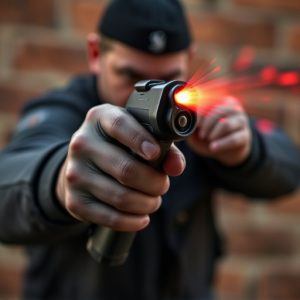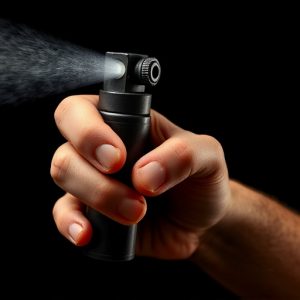Pepper Spray vs Taser: Safety, Effectiveness & Legal Insights
The debate between pepper spray and tasers for self-defense revolves around their unique mechanisms…….
The debate between pepper spray and tasers for self-defense revolves around their unique mechanisms and applications. Pepper spray irritates and temporarily disables through localized irritation, making it ideal for close range and multiple attackers but requires safety protocols like proper storage, understanding its mechanics, and weather awareness. Tasers use electric current to immobilize from a greater distance, less effective in crowded areas, and carry more legal risk due to potential side effects, emphasizing the importance of choosing the right tool based on individual needs, situational awareness, and legal restrictions, with pepper spray vs taser effectiveness differing significantly.
“Discover the power and safety considerations of pepper spray and tasers as self-defense tools in this comprehensive guide. We’ll explore their unique capabilities, offering a swift comparison to help you understand their distinct advantages. Learn essential safety measures for responsible ownership and effective deployment techniques.
Delve into legal aspects and accessibility, including a detailed look at the Pepper Spray vs Taser effectiveness debate, empowering you with knowledge to make informed decisions for personal protection.”
- Understanding Pepper Spray and Tasers: A Quick Comparison
- Safety Measures When Carrying Pepper Spray
- Effective Use of Pepper Spray for Self-Defense
- Legal Considerations and Accessibility of Pepper Spray vs Taser
Understanding Pepper Spray and Tasers: A Quick Comparison
Pepper spray and tasers are both popular self-defense tools, each with unique capabilities. When comparing pepper spray vs taser effectiveness, it’s crucial to understand their mechanisms. Pepper spray irritates the eyes, nose, and respiratory system, temporarily disabling an attacker by causing intense pain and reduced visibility. It’s non-lethal and typically used for close-range defense.
Tasers, on the other hand, use electric current to disrupt muscle control, causing the target to fall to the ground momentarily. Unlike pepper spray, tasers are designed for a more significant distance, allowing users to disable an assailant from farther away. While both offer protection, their effectiveness lies in different approaches: pepper spray focuses on localized irritation, while tasers aim to immobilize through electrical disruption.
Safety Measures When Carrying Pepper Spray
When carrying pepper spray as a self-defense weapon, safety measures are paramount to ensure its effective and responsible use. Always store it in a secure, dedicated carry case that complies with local regulations. Keep it out of reach of children and unauthorized individuals. Familiarize yourself with the spray’s mechanics and understand the range and effectiveness—a key consideration when comparing pepper spray vs Taser effectiveness. Regularly check the expiration date, as the potency of the chemical can degrade over time.
During use, aim for the eyes and face to maximize disruption. Be mindful that wind or weather conditions might affect its accuracy. Pepper spray temporarily incapacitates but does not cause permanent harm; however, it’s crucial to use only what’s necessary. Stay calm and remember that proper usage relies on understanding its limitations, making it a valuable tool when used thoughtfully in self-defense scenarios.
Effective Use of Pepper Spray for Self-Defense
Pepper spray and tasers are both popular self-defense weapons, each with its unique advantages and limitations. When it comes to effectiveness, pepper spray is known for its ability to disable an attacker temporarily by irritating the eyes, nose, and throat. It’s a non-lethal option that can give you precious time to escape or call for help. On the other hand, tasers use electrical current to disrupt muscle control, making them powerful but potentially more dangerous in certain situations.
While both tools can be effective in self-defense scenarios, pepper spray has the upper hand in close-quarters combat due to its ability to create a wide area of effect. Its spray pattern allows for better coverage against multiple attackers. In contrast, tasers require direct contact or proper angle to be effective, making them less useful in crowded or chaotic environments. Therefore, understanding the differences and choosing the right tool based on your specific needs is crucial when considering pepper spray vs. taser effectiveness.
Legal Considerations and Accessibility of Pepper Spray vs Taser
When comparing pepper spray and tasers as self-defense weapons, understanding their legal implications is crucial. Both have distinct regulations and restrictions based on their level of force and impact. Pepper spray, a chemical irritant, is generally considered less lethal than tasers, which deliver an electric shock. This distinction leads to varying legal frameworks; pepper spray may be more accessible in certain jurisdictions due to its classification as a non-lethal weapon. However, the effectiveness of these devices in self-defense scenarios isn’t always about legality or accessibility; it’s also about personal preference and situational awareness.
The debate between pepper spray vs. taser effectiveness revolves around their impact on an assailant, the user’s safety, and potential bystanders. Pepper spray can cause temporary blindness, coughing, and difficulty breathing, allowing the user to escape. Tasers, while designed for immobilization, can lead to more severe side effects in some cases, especially with prolonged use or on individuals with medical conditions. As such, users must consider not just legal restrictions but also the specific circumstances under which they might need to deploy these weapons to make an informed choice between pepper spray and a taser.
When choosing between pepper spray and a taser for self-defense, understanding their unique effectiveness and legal considerations is key. While both offer powerful tools for deterring attacks, pepper spray excels in causing temporary blindness and disorientation, making it highly effective at close range. Tasers, on the other hand, stun targets with an electric shock, providing more distance but potentially leaving users vulnerable during the struggle. In terms of legal accessibility, pepper spray generally faces fewer restrictions, making it a convenient option for personal safety. However, both weapons require responsible handling and safe storage to ensure their effectiveness remains a powerful deterrent without causing harm to others.


